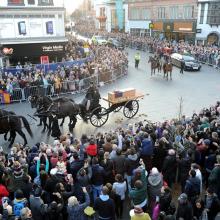King Richard III
Tens of thousands of people in Leicester — England’s most religiously diverse city — are getting ready to honor the memory of a long-despised English king with a ceremony that testifies to the already warm relationship between the Church of England and the Roman Catholic Church.
The bones of King Richard III — who was slain in battle in 1485 and vilified in the writings of William Shakespeare, who described him as a “poisonous bunch-back’d toad” — will be interred at Leicester Cathedral on March 26 at a ceremony led by Archbishop of Canterbury Justin Welby and attended by leading Catholics, Buddhists, Hindus, Sikhs, and Jews, as well as members of England’s royal family.
Richard was the last king of England to die in battle while attempting to defend his throne from Henry VII. The latter went on to establish the Tudor dynasty, whose most memorable monarch was Henry VIII.
After the battle, Richard’s remains were hastily buried by Franciscan monks. In 2012, archaeologists digging in a parking lot found his remains and had the DNA checked with a known survivor of the king’s family.
The hunt for King Richard III's grave is heating up, with archaeologists announcing today that they have located the church where the king was buried in 1485.
"The discoveries so far leave us in no doubt that we are on the site of Leicester's Franciscan Friary, meaning we have crossed the first significant hurdle of the investigation," Richard Buckley, the lead archaeologist on the dig, said in a statement.
Buckley and his colleagues have been excavating a parking lot in Leicester, England, since Aug. 25. They are searching for Greyfriars church, said to be the final resting place of Richard III, who died in battle during the War of the Roses, an English civil war. A century later, Shakespeare would immortalize Richard III in a play of the same name.
After his death in the Battle of Bosworth Field, Richard III was brought to Leicester and buried at Greyfriars. The location of the grave, and the church itself, was eventually lost to history, though University of Leicester archaeologists traced the likely location to beneath the parking lot for the Leicester City Council offices.

